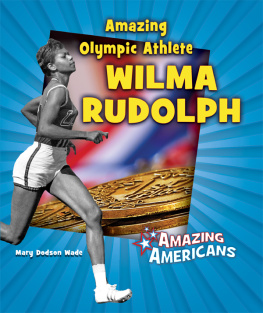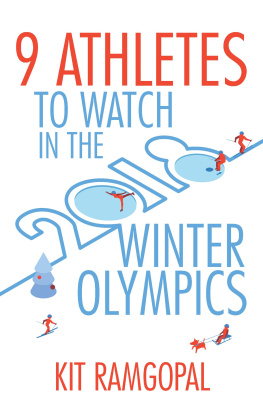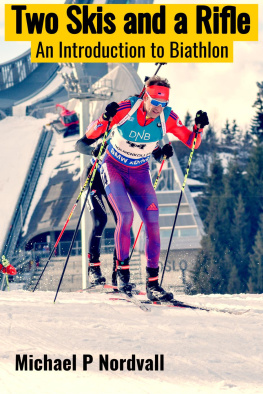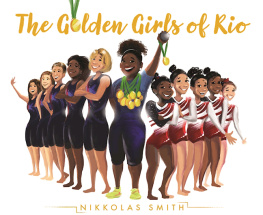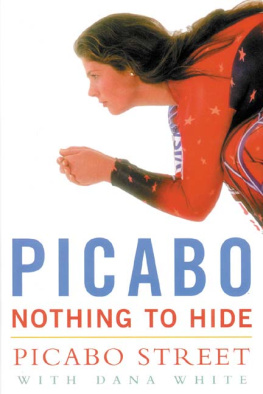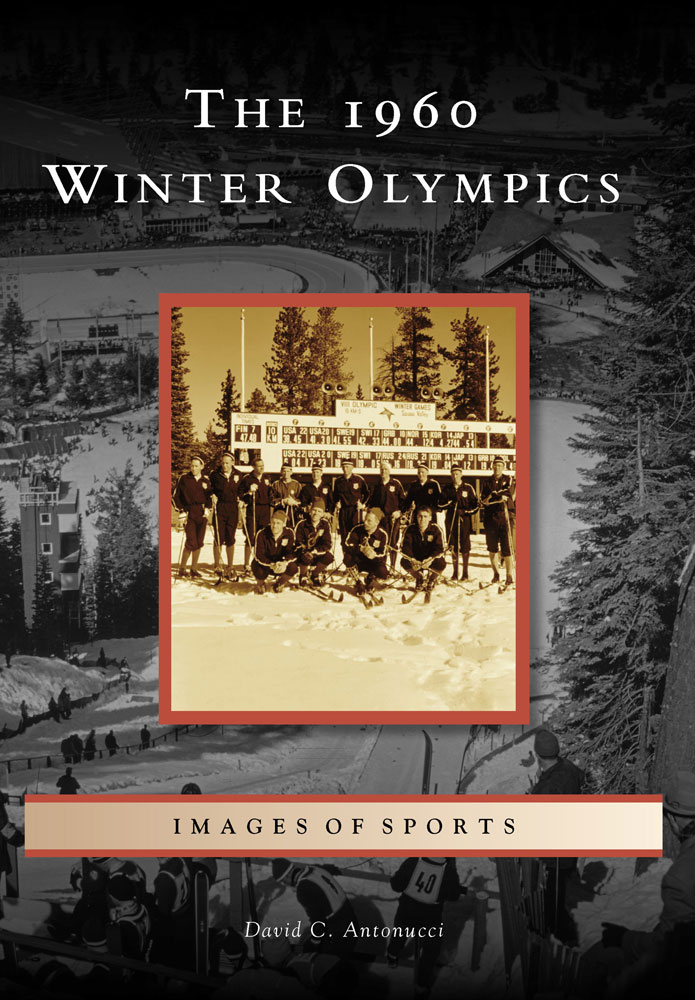
THE 1960
WINTER OLYMPICS
ON THE FRONT COVER: This iconic portrait of the youthful US Nordic and combined ski team includes a prank on the scoreboard showing the United States placing first and second in a mythical 10-kilometer race. (Courtesy of Bill Briner.)
COVER BACKGROUND: This overview of the jumping hill from above the starting gate provides a breathtaking view from an athletes perspective. In the distance on the valley floor is the speed skating oval and the A-framed Nevada Olympic Center to its right. (Courtesy of Bill Briner.)
ON THE BACK COVER: American and Swedish speed skaters warm up on the 400-meter track. The speed skating oval was the first in Olympic history to use an artificially chilled ice surface. (Courtesy of Bill Briner.)
THE 1960
WINTER OLYMPICS

David C. Antonucci

Copyright 2013 by David C. Antonucci
ISBN 978-1-4671-3014-1
Ebook ISBN 9781439642139
Published by Arcadia Publishing
Charleston, South Carolina
Library of Congress Control Number: 2013950225
For all general information, please contact Arcadia Publishing:
Telephone 843-853-2070
Fax 843-853-0044
E-mail
For customer service and orders:
Toll-Free 1-888-313-2665
Visit us on the Internet at www.arcadiapublishing.com
To Jenny and Dominic, for their enduring love and support
CONTENTS
This book would not be possible without the cooperation of many photographic contributors who generously allowed their work to be enjoyed by many. The author is deeply appreciative for the use of their valuable and unique images.
Bill Briner was an official Olympic photographer whose body of work best represents the essence of the 1960 Winter Olympics. Eddy Starr Ancinas was one of 12 official Olympic guides and writes extensively about travel and ski history. The Auburn Ski Clubs Western America SkiSport Museum and its executive director, Bill Clark, have carefully preserved and curated donated collections from the following photographers: John Corbett, a professional photographer in the Truckee area; Richard Hansen, a spectator at the Winter Olympic Games; Russell Stechshulte, an architect responsible for designing and constructing buildings in the Olympic Park; Randy May, a member of the Olympic Ski Patrol; and Floyd Bedbury, an American speed skater who competed in the Winter Games.
Wendall Broomhall, a two-time Olympian, was chief of race for cross-country events, and Martin Hollay was an Olympic worker who helped construct the cross-country courses and biathlon ranges. Dave Newton was a volunteer official at the McKinney Creek cross-country venue. All three provided important photographs and historical information.
The family of Dr. Stan Batiste has collected rare artifacts and memorabilia and put them on public display in Tahoe City. Robert Bonner was a spectator at the Winter Olympic Games. Raleigh DeGeer Amyx is a collector of rare and significant American artifacts. Former professional figure skater Joyce Blackstone provided analysis for descriptive captions for figure skating.
The Walt Disney Family Museum preserves and curates the most extensive collection of Walt Disney artifacts, including objects associated with the 1960 Winter Olympics. The Squaw Valley Ski Museum Foundation seeks to build a permanent ski and Winter Olympics history museum in Squaw Valley.
The 1960 Winter Olympics, known officially as the VIII Olympic Winter Games, began on February 18, 1960, and continued 11 full days through February 28, 1960. Competition events occurred at the California ski resort of Squaw Valley and on the California side of Lake Tahoe, near the vacation community of Tahoma. It was the first complete Winter Games site built from the ground up exclusively for the winter sports competition and in a compact and efficient configuration.
Hailing from 30 countries, 665 athletes competing as amateurs converged to participate in 27 events, including Alpine and Nordic skiing, figure skating, ice hockey, speed skating, biathlon, and ski jumping. Athletes were lodged in a self-contained and restricted-access Olympic Village within walking distance to all competition venues except for Nordic skiing and biathlon.
In Alpine skiing, Germany, Austria, Switzerland, and France dominated the medal counts, but American skier Penny Pitou won two silver medals, and Canadian Anne Heggtveit won a gold medal. Americans Carol Heiss and David Jenkins both received gold medals in individual figure skating. Soviet speed skaters Eugeni Grishin and Lidiya Skoblikova each earned two gold medals in their respective events. German Helmut Recknagel ended Scandinavian domination of the ski jumping with a gold medal and near-perfect jumping scores. The underdog American ice hockey team thunderstruck the Winter Games by going undefeated, overpowering the Soviets, and going on to win the first gold medal in ice hockey for the United States. Finnish cross-country skier Veikko Hakulinen was the most decorated athlete of the games, earning three medals.
The VIII Olympic Winter Games were the watershed for a number of significant Olympic firsts that changed the course of the Olympics. Events were timed electronically, and scoring was tabulated and reported by a computer. Ice events were held on artificially chilled ice. Women were admitted to speed skating competition. Custom-built cross-country courses were prepared using powered mechanical grooming equipment. The sport of the Olympic biathlon debuted here. CBSTV broadcast live 31 hours of coverage throughout the host country. Elaborate opening, closing, and award ceremonies and extensive Olympic Park decorations were directed by Walt Disney.
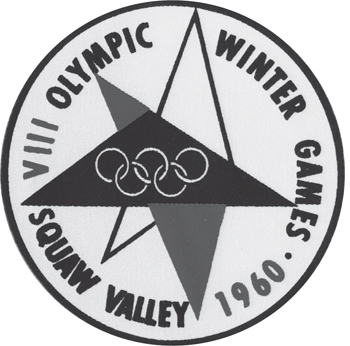
This patch shows the symbolic design of the logo for the VIII Olympic Winter Games. Made of yellow, blue, and red triangles arranged over a white background, it symbolized a star-shaped snowflake. The center triangle replicated the roof line of Blyth Memorial Arena with an overlay of the Olympic rings. Text in a circular border defined the official numeration, its location, and the year. (Courtesy of the Batiste Family Collection.)

Medals for first, second, and third place were struck in bronze and then plated in gold or silver or left in bronze. On the front were the profiles of a man and woman, with raised lettering stating the official name of these Winter Games. On the reverse were the Latin words Citius, Altius, Fortius, translating to Faster, Higher, Stronger, with the Olympic rings and the engraved name of the event. (Courtesy of the Raleigh DeGeer Amyx Collection.)
EARLY SQUAW VALLEY
SKI HISTORY
For millennia, Squaw Valley was a summer grounds for Washoe Native Americans; later, it was part of a nearby mining boomtown and a remote cattle ranch. Squaw Valley lay largely unnoticed. In 1931, a young man and all-round skier from Reno visited the valley and immediately became consumed by his vision of a grand destination ski resort. Wayne Poulsen acquired a key parcel in 1943 and began soliciting investors to bring his vision to reality after World War II.
Poulsen connected with Alexander Cushing in 1948, and the two agreed to launch a ski area. Poulsen provided the land and management expertise, and Cushing infused capital from his connections on the East Coast. The partnership of the two head-strong and visionary entrepreneurs was short lived. Cushing assumed control just before the ski areas grand opening in November 1949. Poulsen retreated to undertake development of the cattle ranch that he now controlled.
Next page

